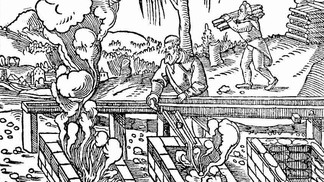Oct 9 2012
New data extracted from Greenland’s glaciers show that methane in the atmosphere follows the waxing and waning of civilizations.
 De Re Metallica 1556 - Public Domain
De Re Metallica 1556 - Public Domain
Humans have been producing substantial amounts of greenhouse gases since long before the industrial revolution, says an article published in Nature on October 4, 2012. By studying the tiny amounts of gases trapped in air bubbles in Greenland’s glaciers, researchers have been able to add details to an emerging picture of historical human induced environmental change that reaches as far back as the Roman Empire and the Han Dynasty. The findings suggest that in the Middle Ages human activities may have contributed significantly to atmospheric methane concentrations, a gas with a climate change potential 25 times that of carbon dioxide.
Over the past millennia, fluctuations in atmospheric methane have been driven by the current of human history, reflecting developments in agricultural practices, technologies, and political and societal organization. “Past societies burnt enormous amounts of wood and charcoal to clear fields, to heat homes and churches, and to smelt metals such as iron, gold, copper or silver,” says Jed Kaplan, group leader at the Atmosphere Regolith Vegetation group at EPFL and co-author of the Nature article. These activities released methane into the atmosphere, at levels that researchers are now able to estimate. The study is an international collaboration led by the Swiss researcher Célia Sapart at Utrecht University in the Netherlands, with research groups participating from Denmark, France and the USA.
A historical model of human land-use
By analyzing the gases trapped in ice-cores extracted from Greenland’s glaciers, researchers are able to reconstruct atmospheric gas concentrations over thousands of years. In the case of methane, they can even reconstruct how it was produced - whether it was emitted by plants, volcanos, or wood fires. But nothing in the ice will tell them if the emissions are from natural or from man-made fires.
Kaplan’s lab provided a global reconstruction of human land-use over the past two millennia, allowing the researchers to detangle human from natural greenhouse gas emissions. While one might naïvely assume that the pre-industrial human contribution to methane emissions was negligible on a global scale, Kaplan’s calculations show that 20 to 30 per cent of methane emitted from fires between 100 BC and 1600 AD is of human origin. Already last year, they published results showing the role of human activities on pre-industrial revolution carbon emissions and came up with equally surprising findings.
A history book in the ice
The study published in Nature produced a time-line of atmospheric methane composition in unprecedented high resolution. When plotted as a graph it reveals troughs and peaks that previous studies had overlooked. Besides natural events such as the Medieval Climate Anomaly and the Little Ice Age, the ice-core records show signs of the Roman Empire and the Han Dynasty as well as the blossoming of societies in the early Middle Ages and the societal slump that followed in the Dark Ages and the blossoming of societies in the Renaissance.
According to Kaplan, even calamities such as the Black Death seem to have caused enough societal turmoil to leave their signature in the ice. One thing that is certain, however, is that human activities since the industrial revolution have added a new, very prominent peak in methane concentrations to Greenland’s glaciers for future generations to study. If, that is, the glaciers are still around then.
Medieval smoke and fire
Medieval smoke and fire from ARVE on Vimeo.
Reference
'Natural and anthropogenic variations in methane sources during the past two millennia',
Célia J. Sapart, G. Monteil, M. Prokopiou, R.S.W. van de Wal, J.O. Kaplan, P. Sperlich, K.M. Krumhardt, C. van der Veen, S. Houweling, M.C. Krol, T. Blunier, T. Sowers, P. Martinerie, E. Witrant, D. Dahl-Jensen en T. Röckmann,
Nature 2012, DOI: 10.1038/nature11461